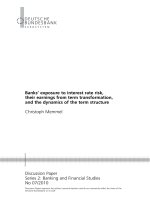Retained Earnings, Treasury Stock, and the Income Statement pptx
Bạn đang xem bản rút gọn của tài liệu. Xem và tải ngay bản đầy đủ của tài liệu tại đây (265.1 KB, 49 trang )
Retained Earnings, Treasury
Stock, and the Income
Statement
Chapter 14
Retained Earnings
and Dividends
•
Retained Earnings shows the amount of
income allowed to accumulate from the
beginning of the corporation’s life to the
present.
•
Retained Earnings represents a claim on
assets, but it is not cash.
Retained Earnings
and Dividends
•
The balance in the Income Summary
account is closed to Retained Earnings at
period end.
•
Dividends are distributions to the
stockholders.
•
To declare dividends there must be
adequate retained earnings.
Objective 1
Account for Stock
Dividends.
Stock Dividends
•
What are stock dividends?
•
They are a proportional distribution of a
corporation’s own stock to shareholders.
•
They do not change total stockholders’
equity.
•
A stock dividend is a transfer of retained
earnings to contributed capital.
Small Stock Dividend Example
•
The dividend is valued at the product of
the number of shares distributed times the
market price at declaration date.
•
San Diego Company, with 300,000 shares
of $2 par value common stock outstanding,
declares a 15% stock dividend when the
shares are trading at $20.
Small Stock Dividend Example
•
How much stock do the shareholders
receive?
•
300,000 × 15% = 45,000 shares
•
45,000 at $20 per share = $900,000, and
45,000 at $2 per share = $90,000
What is the entry when the dividend is distributed?
Small Stock Dividend Example
Retained Earnings 900,000
Common Stock 90,000
Paid-in Capital in
Excess of Par 810,000
15% common stock dividend distributed
Stock Split
•
This is an increase in the number of
authorized, issued, and outstanding shares.
•
It is a reduction in the par value.
•
The market value is usually affected
proportionately.
Stock Split
•
A 5-for-1 stock split means that the
company would have five times as many
shares outstanding after the split as it had
before.
•
Each share’s par value would be divided
by five.
Stock Split Example
•
Prior to a 5-for-1 split, San Diego
Company had 500,000 shares of $10 par
common stock authorized and 100,000
issued.
•
After the split, 2,500,000 are authorized.
•
500,000 are issued.
•
What is the par value per share?
•
$10 ÷ 5 = $2
Objective 2
Distinguish Stock
Splits
from Stock Dividends.
Similarities Between Stock
Splits and Stock Dividends
Both increase the number of shares
of stock owned per stockholder.
Neither change the investor’s
cost of the stock they own.
Neither type of income creates
taxable income for the investor.
Differences Between Stock
Splits and Stock Dividends
•
A stock dividend shifts an amount from
retained earnings to paid-in capital.
•
The par value per share remains
unchanged.
•
A stock split affects no account balance.
•
It changes the par value of the stock.
•
It increases the number of shares of stock
authorized, issued, and outstanding.
Objective 3
Account for Treasury
Stock.
Treasury Stock
…are shares that a company has issued and
later reacquired.
•
Purchasing treasury stock decreases assets
and stockholders’ equity.
Treasury Stock Example
•
San Diego Company purchased 1,000
shares of its own $10 par value common
stock at $20 per share (500,000 shares are
authorized, 10,000 are issued.)
Treasury Stock 20,000
Cash 20,000
Purchased 1,000 shares of treasury stock
Treasury Stock Example
Stockholders’ Equity
(Before purchase of treasury stock)
Common stock, $10 par, 10,000 issued $100,000
+ Paid-in capital in excess of par 800,000
= Total paid-in capital $900,000
+ Retained earnings 50,000
= Total stockholders’ equity $950,000
Treasury Stock Example
(After purchase of treasury stock)
Common stock, $10 par, 10,000 issued,
9,000 outstanding $100,000
+ Paid-in capital in excess of par 800,000
+ Retained earnings 50,000
= Subtotal $950,000
– Treasury stock, 1,000 shares 20,000
= Total stockholders’ equity $930,000
Sale of Treasury Stock Example
•
No gain or loss is recognized on the sale of
treasury shares.
•
Excess of sales price over cost is credited
to Paid-in Capital-Treasury Stock
transactions.
•
Assume that 100 shares of treasury stock
are sold at $22.
Cash 2,200
Treasury Stock 2,000
Paid-In Capital from
Treasury Stock 200
Sold 100 shares of treasury stock
Sale of Treasury Stock Example
What if 100 shares of treasury stock are sold at $18?
Cash 1,800
Paid-In Capital from
Treasury Stock 200
Treasury Stock 2,000
Sold 100 shares of treasury stock
Sale of Treasury Stock Example
Sale of Treasury Stock Example
•
What if the resale price is less than cost?
•
Debit Paid-in Capital from Treasury Stock
Transactions.
•
Debit Retained Earnings if the Paid-in
Capital from Treasury Stock Transactions
is too small.
Retirement of Stock
…decreases the outstanding stock of the
corporation.
•
Retired shares cannot be reissued.
•
There is no gain or loss on retirement.
Objective 4
Report Restrictions
on
Retained Earnings.









